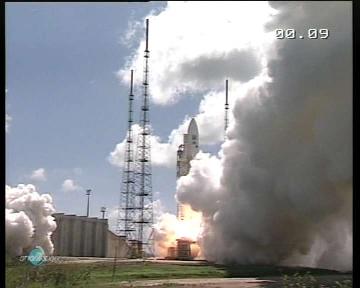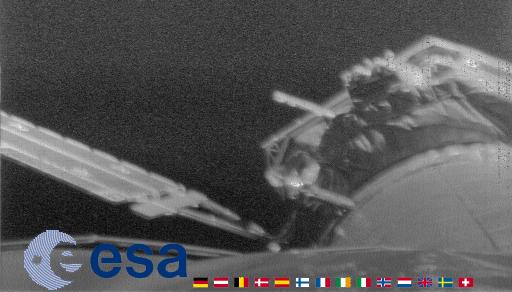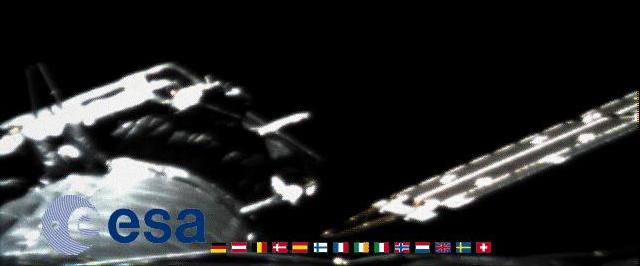
Credit: ESA
Upper left: The launch of XMM. Upper right: Picture
taken by the FUGA camera showing the telescope tube and one solar array on the
left. At the top of the picture, one sees the edges of the now deployed
telescope sunshield. What appears as a white boom in centre is in fact one
of the fixed lateral sunshield panels, seen side-on. Lower: Picture taken
by the IRIS camera shows the other solar array on right. At the bottom of
the photograph (below the ESA flags) is the MLI thermal insulation just
under the lens of the camera.
The Launch of XMM
The X-ray telescope XMM, the
X-ray Multi-Mirror Mission, is the second cornerstone of the Horizon 2000
program of the European Space Agency
(ESA). The XMM spacecraft was launched by ESA on
board an Ariane-5 rocket at 14:32 UTC (9:32 am eastern daylight time) on
December 10. The launch was carried live
on the world-wide web. The telescope will be put into an elliptical orbit
71,250 miles by 4,300 miles and will take 48 hours to go around the Earth
once. The observatory consists of three coaligned high throughput 7.5m
focal length telescopes with 6 arc second FWHM (15 arc second HPD) angular
resolution. XMM will provide images over a 30 arc minute field of view with
moderate spectral resolution using the European Photon
Imaging Camera (EPIC). High-resolution spectral information is provided
by the Reflection
Grating Spectrometer (RGS). The observatory also has a coaligned 30cm
optical/UV telescope called the Optical Monitor
(OM).
Shortly after launch 2 micro-cameras on board XMM were turned on. Provided
by OIP (a subsidiary of Delft Sensor Systems Antwerpen, Belgium), the two
cameras (10 x 6 x 6cm) each weigh only 430 grams. The cameras are of two
types: the FUGA camera has a logarithmic response, with a high dynamic
range, providing black and white pictures. The second camera (IRIS) is
equipped with a color filter. The field of view of both cameras is fixed
(approx. 40° x 40°), giving a view along the telescope tube towards the
service platform and the solar arrays. The pictures above pictures were
taken just under five hours after liftoff, at 19:25 UT (14:25 EDT). XMM was
then at an altitude of 55,300 km above the Earth's surface.
Last Week *
HEA Dictionary * Archive
* Search HEAPOW
* Education
Each week the HEASARC
brings you new, exciting and beautiful images from X-ray and Gamma ray
astronomy. Check back each week and be sure to check out the HEAPOW archive!
Page Author: Dr. Michael F.
Corcoran
Last modified May 26, 2001




